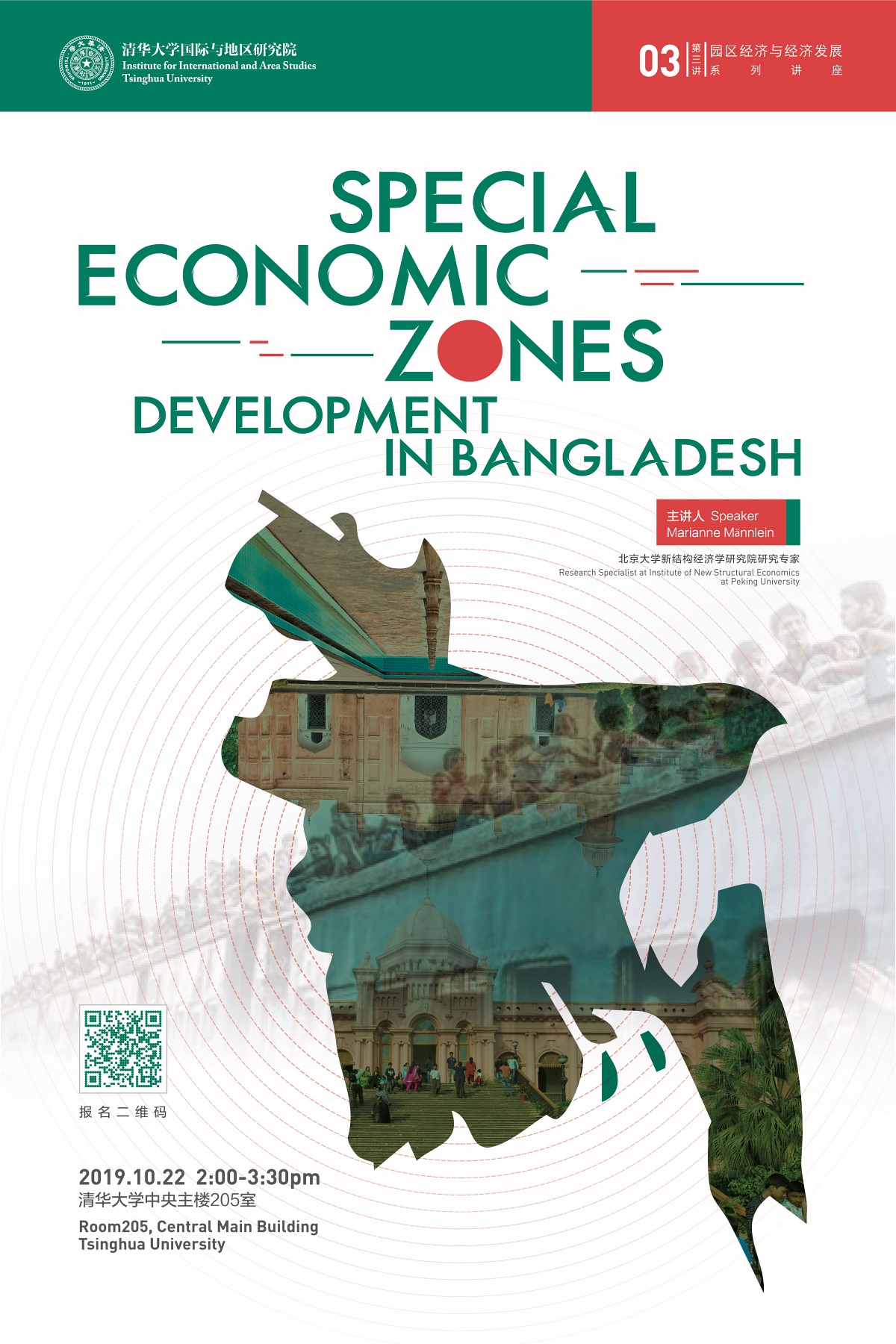
Park Economy and Economic Development Lecture Series: Lecture 3 | The Development of Special Economic Zones in Bangladesh

On the afternoon of October 22, 2019, the third session of the Park Economy and Economic Development Lecture Series titled “The Development of Special Economic Zones in Bangladesh” was held at the Conference Room 205 of the Central Main Building of Tsinghua University. Ms. Marianne Männlein, Research Specialist of the Institute of New Structural Economics of Peking University was specially invited to give a lecture, which were attended by doctoral students from the Institute of International and Area Studies (IIAS) of Tsinghua University.
At the beginning, Ms. Marianne introduced the Institute of New Structural Economics of Peking University she is working at and also described the definition of “new structural economy”. The lecture was divided into three parts, namely special economic zone from the perspective of New Structural Economics, international projects related to new special economic zones at the Institute of New Structural Economics of Peking University, and her findings on the development of special economic zones in Bangladesh.
First of all, Ms. Marianne pointed out that as a catalyst, special economic zones can realize industrial transfer with limited resources. It has the following four functions: to concentrate resources in small areas to create competitive conditions; to attract pioneers in the industry, build trust, and achieve demonstration effects; to promote capital inflows, create jobs, exports, and foreign exchange; and to drive structural changes, including capital accumulation, cluster formation, connections, technology transfer, industrial upgrading and capacity building.
Next, she elaborated the architecture of the Institute of New Structural Economics and pointed out that the Institute of New Structural Economics of Peking University has launched a special economic zone monitoring and evaluation project. The goal is to establish a continuous collection and inclusion in the special economic zone. The standardized multi-country data set of quantitative and qualitative observations will overcome the current data gap. This method is expected to provide actionable insights to help decision makers and other stakeholders make decisions and maximize their benefits, including structural transformation and sustainable development goals. In order to determine appropriate indicators and data collection methods, it is cooperating with local agencies in partner countries to develop corresponding monitoring and evaluation projects through national pilot projects. Ms. Marianne mentioned that in 2010, the Bangladesh Economic Zone Authority was established, aiming to establish 100 economic zones across the country. Compared with the existing zones in Bangladesh, the special economic zones have a wider range and include the private sector and other partners. A study of new projects in Bangladesh found that the domestic private sector is enthusiastically joining in, and some private economic zones are already operating. However, administrative, financing, and infrastructure bottlenecks hindered the progress. Some policies to streamline the administrative processes of the special economic zone have been approved but have not yet been implemented. System-wide deficiencies that affect the development of the entire industry are still the main concerns of Bangladeshi business owners. In particular, the financing channels for long-term investments are restricted and the supporting infrastructure is seriously blocked. As for public economic zones, field research shows that their development speed is relatively slow, and none of them are currently operational. In general, economic zone projects are still in the early stages of development and rules are being drafted. Although many projects have been approved, few of them have actually started.
Ms. Marianne further pointed out that a comparative analysis of the historical development of special economic zones in India, Pakistan and Bangladesh shows that the conditions for the success of the plans can be summarized as follows: Enjoy political commitment within the broader economic strategy; supported by specialized policies and governance frameworks; and implemented transparently and adaptively. In comparison, China’s experience in special economic zones can also provide inspirations to Bangladesh and other developing countries. In 1978, China’s special economic zone was regarded as a testing ground for economic reforms. Since then, China’s special economic zones have developed into various models to prepare China for the new challenges brought about by the evolution of the economic structure, which is quite inspiring for Bangladesh’s new special economic zones. Therefore, in addition to the early industrialization success in the export of low-value-added garments, the country is now facing the challenge of economic upgrading and diversification. She highlighted that in general, it is a very important step for southern countries to direct scarce resources to special economic zones to maximize their chances of success. Special economic zones also provide a unique platform for direct South-South cooperation. As an investment channel, special economic zones help to achieve connectivity between southern economies, which are undergoing the transformation of economic structure in Asia, such as the private Chinese overseas special economic zones in Africa or the planned inter-government special economic zones in Bangladesh. If adopted by enough countries, the monitoring and evaluation project may accelerate learning by collecting, summarizing and sharing all these lessons at the multilateral level.

Related Content
- Russian Economy and Eurasian Economy Lecture Series: Lecture 5 | Russia’s Economic Growth Model and Resource Dependence
- Russian Economy and Eurasian Economy Lecture Series: Lecture 4 | Russia’s Economic Strength and Social Development
- Russian Economy and Eurasian Economy Lecture Series: Lecture 3 | Russia’s Economic Transformation and Building of Modern Market Economy
- Russian Economy and Eurasian Economy Lecture Series: Lecture 2 | The Relevance of Historical and Cultural Factors to World Economic Analysis: A Case Study on the Economy of Russia and Ukraine Before and After the Conflict

